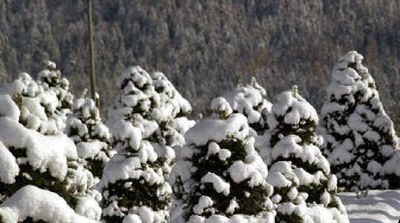Consider a live holiday tree

For many people, a traditional, cut Christmas tree, or an artificial tree just doesn’t cut it anymore.
Some don’t like the idea of cutting down a tree just to be able to enjoy it inside for just a few days – that seems like the waste of a good tree.
For others, the cost of a cut tree is getting high enough that it seems more prudent to buy something that will last longer than the Christmas season.
For still others, the only ambience an artificial tree has is convenience.
Live trees have several advantages over cut or artificial trees: They are much less of a fire hazard than a cut tree; they have a fragrance all their own that lasts through its time in the house; and after the holidays are over, a live tree can be placed in the garden for years of continuing beauty.
Having a living tree does take some advance planning and it can die very easily with improper handling.
First, buy a nursery grown tree from a good nursery. It should be a healthy green with no shedding needles and in a pot with a reasonable amount of potting mix or mulch around it. Keep in mind that the tree will be heavy with its root ball and all, so a smaller tree will be easier to move around. A 6-foot tree with a good root ball can weigh 100 pounds or more when watered.
When you bring the tree home, leave it outdoors where it can get lots of sun and rain. Water it if there is no rain.
Living trees can’t be kept in the house for long periods like cut trees.
“Ten days maximum in the house,” says Nancy Williamson, nursery manager at Stanek’s, on Spokane’s South Hill. If left in the warm house too long, the tree would begin to break out of dormancy, a process that can’t be reversed and could kill the tree once it is put back outside.
“I recommend acclimating the tree, two to three days in the garage, (then) into the house and then reacclimatize it two to three days in the garage (before) going back out,” says Williamson. This allows the tree to adjust a bit so the warmth indoors isn’t as much of a shock. Water it well before bringing it inside.
Once in the house, place the tree in a cool space where it can get good bright light and away from heat sources like furnace vents and fireplaces. Keep hot Christmas lights to a minimum as they can easily cook needles if they are too close.
Like a cut tree, your live tree will need to be watered every day. An easy way to do this is to put a tray of ice cubes on top of the root ball where they will melt and soak in.
“(The water) doesn’t rush right through and it does a slow melt and doesn’t get water all over the place,” says Williamson.
If you want to plant the tree in your garden, plan the space before you buy. Most trees used for Christmas trees can grow to 40-, even 70-feet tall or more with time. That’s a lot of room in an urban garden.
If the ground is likely to freeze before you plant the tree, hurry up and dig the hole now, then store the fill dirt where it won’t freeze. The hole should be as deep as the root ball and dish-shaped out 3 or 4 feet from the center. Fill it with pine needles or straw to insulate it.
Plant the tree as soon as you move it out of its transition place. If it’s above freezing, water it well and then water it through the winter when it’s warm enough.
Don’t want to go through all this fuss? Well, living trees can be left outside and placed where you can see them from a window. Decorate them simply with bird-friendly foods like seed cakes, suet blocks, fruit slices and the like. If the birds find it by Christmas morning, you can watch them as you open your gifts.
You can also cluster small evergreens like potted boxwoods, hollies, columnar junipers and small conifers together near the front door or window for a bigger effect.
If the trees are under an overhang or roof eave, where they are not going to get hit with rain or snow, remember to water them regularly every 10 days to two weeks.
If they are in a shaded area, turn them a quarter turn every few days to give the plant enough light all the way around.
Once the holidays are over, move them back outside where they can get good light and adequate water.
“If it isn’t out where it could get rain or snow, you need to water it,” says Williamson. “Especially, like last winter, when we didn’t get any snow or rain.”
Cluster the trees together out of the direct winter sun and mulch them with leaves or pines needles to keep the root balls from freezing and thawing too much. Even hardy plants can die in pots if their roots are torn up too much by expanding ice crystals.